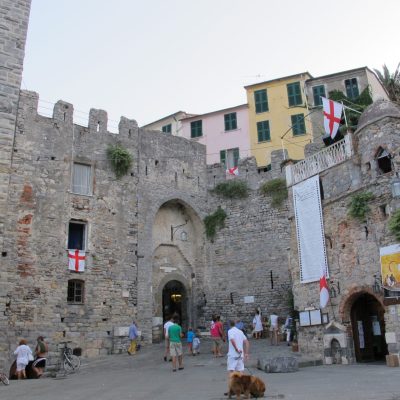
Territory
Portovenere
Portovenere is one of the most famous italian seaside resort. The Romans already knew this village, so colled for the presence of a temple consecrated to Venus, the goddess of beauty.
During the Medieval Age, it was feud of the Lords of Vezzano, then it passed under the control of Genoa, during the 12th century. It was heavily damaged in 1494, when attacked by Alfonso of Aragon’s fleet. The “Castrum Vetus”, the first real urban centre, that is actually disappeared, was closed to Saint Peter’s Church. In 1139 Genoa began to built the zone aroun the modern Cappellini Street, and it strengthened the defences of the village thanks to a new castle and some stately town-walls.
It seems to be just in 1139 the submission of Portovenere to Genoa, also if we can read the inscription “Colonia Jenuensis 1113” on a tablet retained on an ancient gate of the walls.
The characteristics of the houses that face the harbour is their high and narrow shape; their façades are painted with fast colours (mainly red Romanic but in the extreme western side of the village, there are more ancient Tuscan houses, with ogival arches
During the Medieval Age, it was feud of the Lords of Vezzano, then it passed under the control of Genoa, during the 12th century. It was heavily damaged in 1494, when attacked by Alfonso of Aragon’s fleet. The “Castrum Vetus”, the first real urban centre, that is actually disappeared, was closed to Saint Peter’s Church. In 1139 Genoa began to built the zone aroun the modern Cappellini Street, and it strengthened the defences of the village thanks to a new castle and some stately town-walls.
It seems to be just in 1139 the submission of Portovenere to Genoa, also if we can read the inscription “Colonia Jenuensis 1113” on a tablet retained on an ancient gate of the walls.
The characteristics of the houses that face the harbour is their high and narrow shape; their façades are painted with fast colours (mainly red Romanic but in the extreme western side of the village, there are more ancient Tuscan houses, with ogival arches
Houses have generally two entrances, one facing the beach for the boats and another facing the street, the typical “carruggio” that runs parallel with the coast, but on a higher level.
Their typical structure presents three rooms on every floor; the central floor has no windows. Houses are leant one to another for defensive reasons, too.
Inside the village there aren’t cross-streets but only some little arcades (called “capitoli”) that link the street with the harbour or with the beach, through little steep stairs. Saint Peter’s Church is located just on the western cape of the village; it’s a typical ligurian romanic-gothic building, erected on the rests of the ancient temple of Venus. From here people can enjoy a wonderful view: from the little romanic loggia you can observe the starting coastal part of the Cinque Terre, while the front door of the church dominates the Gulf and the opposite island (Palmaria). Saint Peter’s shape recalls a big rocky boat and it’s the outcome of a lot of different building’s stages
Their typical structure presents three rooms on every floor; the central floor has no windows. Houses are leant one to another for defensive reasons, too.
Inside the village there aren’t cross-streets but only some little arcades (called “capitoli”) that link the street with the harbour or with the beach, through little steep stairs. Saint Peter’s Church is located just on the western cape of the village; it’s a typical ligurian romanic-gothic building, erected on the rests of the ancient temple of Venus. From here people can enjoy a wonderful view: from the little romanic loggia you can observe the starting coastal part of the Cinque Terre, while the front door of the church dominates the Gulf and the opposite island (Palmaria). Saint Peter’s shape recalls a big rocky boat and it’s the outcome of a lot of different building’s stages





